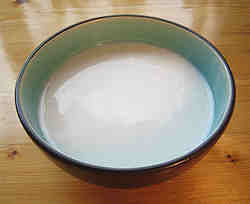Howdy! Friends, guests, ladies and gentlemen, its another fresh year. Home of good ideas extends its greetings to our avid visitors.
It seems we ran out of post during the Christmas season because of many celebrations, parties, and out of town trips. But we are back again this time. As an opener for January 2010, we offer you new recipes in our Monday cooking. For Filipinos out there you will like this features as we refresh our appetites with traditional foods served with a popular Filipino ingredient, the coconut cream -"gata." And for sure you must have heard the health benefits of taking MCFA 0r medium chain fatty acids, especially lauric acid abundantly found in coconut oil. We will be having a feature about it in our Health and Family section later this month.
 In preparation for the coming coconut milk based dishes, we share with you a simple way to prepare your coconut milk or "gata."
In preparation for the coming coconut milk based dishes, we share with you a simple way to prepare your coconut milk or "gata."You need a mature coconut, husk removed and cut into half with the water set aside for other use. A mature coconut has a hard meat and a hard and dark brown shell. Coconut is available in local markets.
Coconut milk has 2 categories, the thick and the thin. Thick milk is obtained by directly pressing the grated coconut milk, however if extracting out of 1 coconut only, 1/2 cup of clean water (previously boiled and allowed to cool) can be added to easily remove the milk. Then the milk is strained in clean cheesecloth to remove the solids. Set aside and use in the cooking.
The thin coconut milk can be derived from the grates previously extracted with the thick milk. Add 1 cup water to the grates and extract. Repeat 2 to 3 times more and combine the extract then strain. Set aside the thin milk for use in the cooking.
The milk out of this process is fresh and can be used directly or chilled and use within the next day. Prolonged storage may affect quality of food.
image from wikipedia.org

thanks for the info.
ReplyDeletehappy new year
HI Romy!
ReplyDeletethanks for the visit. nia ko sa Sydney. good to know you have a friend here. akong gi apilan nga Filipino Association kay Visayan Association then mag attend sad ko ug Filipino Fiesta usahay. basin nakita na nako siya but wala lang ko kaila. Karon Jan kay naa sad Sinulog nakahunahuna ko sa pag attend pohon kay dool ra sa amo. I will take note of his name kay basin magka ila ila mi pohon
thanks and regards
Wow, naman marunong pala kayong mag cross stich. That must be similar to this. I like when its autumn because the ground is colorful as well as the trees.
ReplyDeleteHave a nice day!